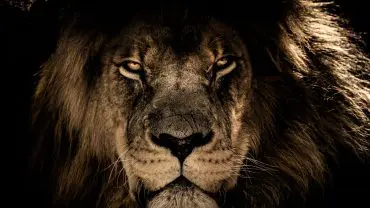The Asiatic lion is one of five big cats native to India along with the Indian, clouded and snow leopards and the magnificent Bengal tiger. This amazing lion is a fierce, brave leader and has been brought back from the brink of extinction. Today one of the best facts about Asiatic lions is that their numbers are steadily growing. Here, we’ll tell you everything you need to know about the Asiatic lion.
What Do Asiatic Lions Look Like?

Asiatic Lion walking in jungle of Gir National Park in India. (Photo: ibrandcare via iStock)
This incredible lion from India has pale brown to sandy coloured fur and the males have shorter manes than their African cousins, so their ears are always visible. Perhaps the most distinguishing characteristic of the Asian lion is that it has a long fold of skin that runs the full length of its belly which is absent in African lions.
How Big are Asiatic Lions and How Long do they Live?

Asiatic lion. A critically endangered species. (Photo: xtrekx via iStock)
The lion from India is a little smaller than the African lion but even so, they are mighty creatures. Males are between 2.1 metres and 2.9 metres long and can weigh up to 190kg, while females are smaller, measuring between 1.4 metres and 1.8 metres, tipping the scales at about 130kg.
As with all large animals, there are stories of exceptionally large specimens. A male speared in the seventeenth century reputedly measured 3.1 metres and weighed a staggering 306kg. Another tale of an Asian lion in Iran in 1841 was described as ‘unusually large’ but these stories are usually exaggerations.
In the wild, the Indian lion lives for between 15 and 18 years. In captivity, with the proper medical care, food and a life free of the stresses of competition, disease and poachers, they can live to about 20. In 2018 it was reported that Arjun, a male at the Indira Gandhi Zoological Park in India died at the age of 29. He was possibly the oldest lion ever.
Where Do Asiatic Lions Live?

Asiatic Lion at Gir National Park, India (Photo: AriImages via iStock)
The historic range of the mighty Asiatic lion was vast, stretching east from Greece in southeastern Europe through Turkey, the Middle East, Armenia, Azerbaijan, Georgia, Iran, Iraq, Pakistan, Afghanistan and as far as India’s eastern border with Bangladesh.
Slowly, these lions were hunted to the brink of extinction. By the 1890s it was extinct in Greece, Saudi Arabia and Turkey and the last known lion in Iraq was killed in 1918. By the mid-twentieth century it was extinct in Iran.
The population of this lion from India was at one time many thousands strong but – due in large part to human intervention – the numbers were quickly whittled down in the nineteenth century until only ten or twelve survived.
Today, the only population survives in the dry deciduous forests, thorny forests and savannahs of the protected Gir National Park and Wildlife Sanctuary and the surrounding areas in the western Indian state of Gujarat. Thanks to incredible conservation efforts, the population has grown to around 700, an increase of about 30% since 2015.
What Do Asiatic Lions Eat?

Asiatic Lion bares his teeth (Photo: Thorsten Spoerlein via iStock)
Like all big cats, lions are carnivores and they have a preference for large prey. They dine on domestic cattle, chittal (a spotted deer), sambar deer when they come down from the hills in summertime, nilgai (the largest Asian antelope) and water buffalo. In the hot summer months they will also feed on mugger, or marsh crocodiles.
The primary hunters are the females, who will kill most of their prey close to water sources and then drag the carcass into thick cover. After the hunt, the pride will often squabble over their share of the kill, and they have also been known to steal kills from hyenas and wild dogs.
Asian Lion Facts

A pair of asiatic lions (Photo: Thorsten Spoerlein via iStock)
Were there Wild Lions in Europe?
In 1978, German zooarchaeologists excavating Tiryns in Greece discovered a heel bone from a female lion. Over the following decades, dozens more lion bones were discovered. It has now been concluded that lions lived alongside humans in parts of southeastern Europe. They have come to be known as The Last Wild Lions of Europe.
Pride In The Name of Love
African and Asiatic lions are the only big cats that live in groups. A pride may include up to three males, alongside ten to twelve females and their cubs. Usually, all the females are related, and the female cubs will stay within the pride. The young males will often leave to form their own prides, taking over an existing pride from a weaker male.
Under Threat
Even though the number of wild Asiatic lions is steadily increasing, they are listed as ‘Endangered’ by the International Union for Conservation of Nature. As the only remaining population occupies the same space, one outbreak of a contagious disease or a natural disaster could have catastrophic consequences for the species.
Cultural Icons
Lions, including the Asian lion, have been important symbols in Asian, Middle Eastern and European cultures for tens of thousands of years. The earliest known depictions of lions are cave drawings from the famous Lascaux caves in France around 32,000 years ago. The 31.1cm Löwenmensch figurine, known as the Lion-man or the Lion-human – an ivory sculpture found in the Hohlenstein-Stadel cave in 1939 – was carved from a mammoth tusk around 39,000 years ago by the Aurignacian people.












